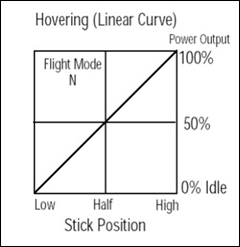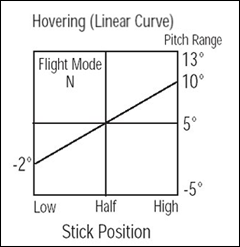T-Rex 250 Setup: Difference between revisions
(→ESC) |
(→Gyro) |
||
| Line 18: | Line 18: | ||
== Gyro == | == Gyro == | ||
GP750 settings: | |||
* Pulse frame: 1520us | |||
* Servo type: DS (Digital Servo) | |||
* Direction: Rev (mounted up-side-down) | |||
* Servo travel: Limit set with no binding | |||
* Heli type: Small heli | |||
* Delay: 0 delay | |||
* [http://www.rcgroups.com/forums/showthread.php?t=948174 Mini-HowTo - Align GP-750 Heading Lock Gyro] | * [http://www.rcgroups.com/forums/showthread.php?t=948174 Mini-HowTo - Align GP-750 Heading Lock Gyro] | ||
Revision as of 15:40, 28 April 2009
Rotor
Tail
Radio
A good radio normally has a dual-rate switch on to of the radio for Normal Mode (hovering), Stunt Mode #1 (3D), and Stunt Mode #2 (more power 3D). Stunt mode is also referred to as IdleUp 1 and IdleUp 2. Another mode is Throttle Hold for auto-rotation on engine failure, a second switch is normally used for this.
File:Helicopter dualrate switch.jpg
Normal Mode is used during spin-up and hovering. With the stick down the engine will be off and with 70% up the helicopter should be hovering. These parameters are mainly set-up on the radio by altering the engine throttle and rotor pitch curve.
With Stunt Mode turned on the hovering mode is turned into a flexible mode where the helicopter can be flown up-side-down. Essentially the Normal Mode above 50% is mirrored to the 0-49% section of the stick, but with a negative rotor pitch instead. Look at the picture below to understand the difference between Normal and Stunt.

 File:Helicopter stuntmode throttle.png
File:Helicopter stuntmode pitch.png
File:Helicopter stuntmode throttle.png
File:Helicopter stuntmode pitch.png
Gyro
GP750 settings:
- Pulse frame: 1520us
- Servo type: DS (Digital Servo)
- Direction: Rev (mounted up-side-down)
- Servo travel: Limit set with no binding
- Heli type: Small heli
- Delay: 0 delay
ESC
The default configuration:
- Soft start
- 6v BEC to receiver/servos
Although the ESC is pre-programmed from factory, re-program it to make sure the throttle range matches the transmitter stick range. It also fixes any issues that might be introduced during manufacturing or storage.